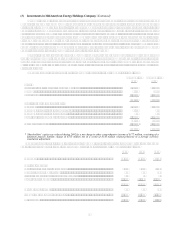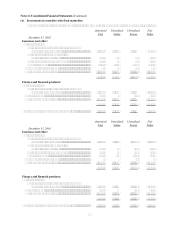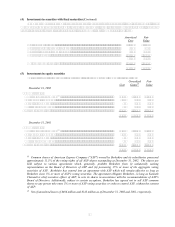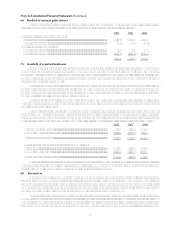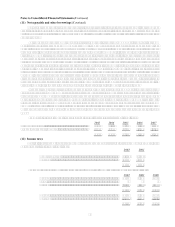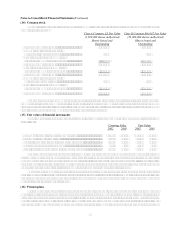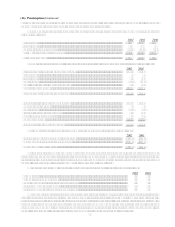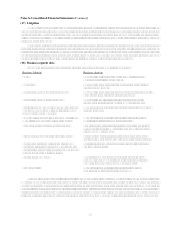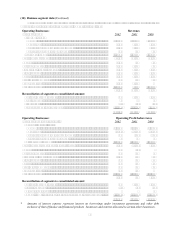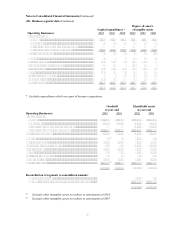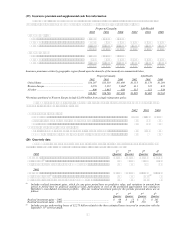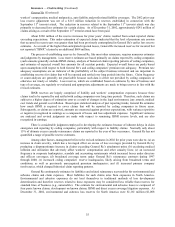Berkshire Hathaway 2002 Annual Report Download - page 47
Download and view the complete annual report
Please find page 47 of the 2002 Berkshire Hathaway annual report below. You can navigate through the pages in the report by either clicking on the pages listed below, or by using the keyword search tool below to find specific information within the annual report.
46
Notes to Consolidated Financial Statements (Continued)
(14) Common stock
Changes in issued and outstanding Berkshire common stock during the three years ended December 31, 2002 are
shown in the table below. Class A Common, $5 Par Value Class B Common $0.1667 Par Value
(1,650,000 shares authorized) (55,000,000 shares authorized)
Shares Issued and Shares Issued and
Outstanding Outstanding
Balance December 31, 1999..................................... 1,341,663 5,366,955
Common stock issued in connection
with acquisitions of businesses.............................. 3,572 1,626
Conversions of Class A common stock
to Class B common stock and other ...................... (1,331) 101,205
Balance December 31, 2000..................................... 1,343,904 5,469,786
Conversions of Class A common stock
to Class B common stock and other ...................... (20,494) 674,436
Balance December 31, 2001..................................... 1,323,410 6,144,222
Common stock issued in connection
with a business acquisition .................................... 4,505 7,063
Conversions of Class A common stock
to Class B common stock and other ...................... (16,729) 552,832
Balance December 31, 2002..................................... 1,311,186 6,704,117
Each share of Class A common stock is convertible, at the option of the holder, into thirty shares of Class B
common stock. Class B common stock is not convertible into Class A common stock. Each share of Class B common
stock possesses voting rights equivalent to one-two-hundredth (1/200) of the voting rights of a share of Class A common
stock. Class A and Class B common shares vote together as a single class.
(15) Fair values of financial instruments
The estimated fair values of Berkshires financial instruments as of December 31, 2002 and 2001, are as follows
(in millions). Carrying Value Fair Value
2002 2001 2002 2001
Investments in securities with fixed maturities .................................... $38,096 $36,219 $38,096 $36,219
Investments in equity securities ........................................................... 28,363 28,675 28,363 28,675
Assets of finance and financial products businesses ............................ 33,578 41,591 33,881 41,710
Notes payable and other borrowings.................................................... 4,807 3,485 4,957 3,624
Liabilities of finance and financial products businesses....................... 28,726 37,791 29,090 37,917
In determining fair value of financial instruments, Berkshire used quoted market prices when available. For
instruments where quoted market prices were not available, independent pricing services or appraisals by Berkshires
management were used. Those services and appraisals reflected the estimated present values utilizing current risk
adjusted market rates of similar instruments. The carrying values of cash and cash equivalents, receivables and accounts
payable, accruals and other liabilities are deemed to be reasonable estimates of their fair values.
Considerable judgment is necessarily required in interpreting market data used to develop the estimates of fair
value. Accordingly, the estimates presented herein are not necessarily indicative of the amounts that could be realized in
a current market exchange. The use of different market assumptions and/or estimation methodologies may have a
material effect on the estimated fair value.
(16) Pension plans
Certain Berkshire subsidiaries individually sponsor defined benefit pension plans covering their employees.
Benefits under the plans are generally based on years of service and compensation, although benefits under certain plans
are based on years of service and fixed benefit rates. Funding policies are generally to contribute amounts required to
meet regulatory requirements plus additional amounts determined by management based on actuarial valuations. Most
plans for U.S. employees are funded through assets held in trust. However, pension obligations under plans for non-



